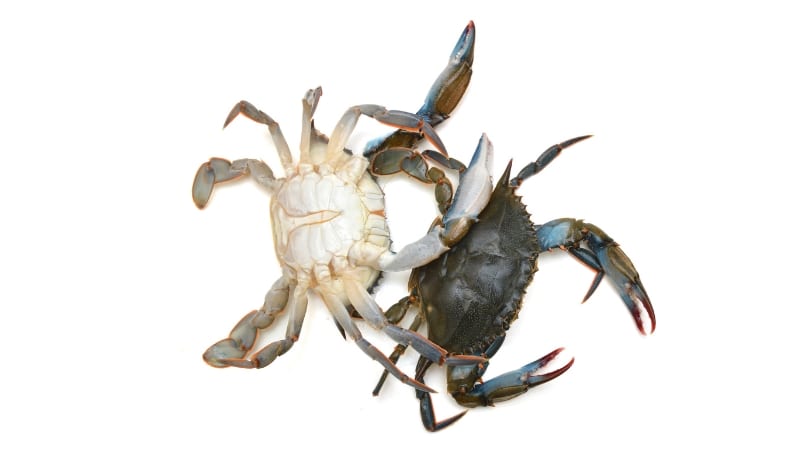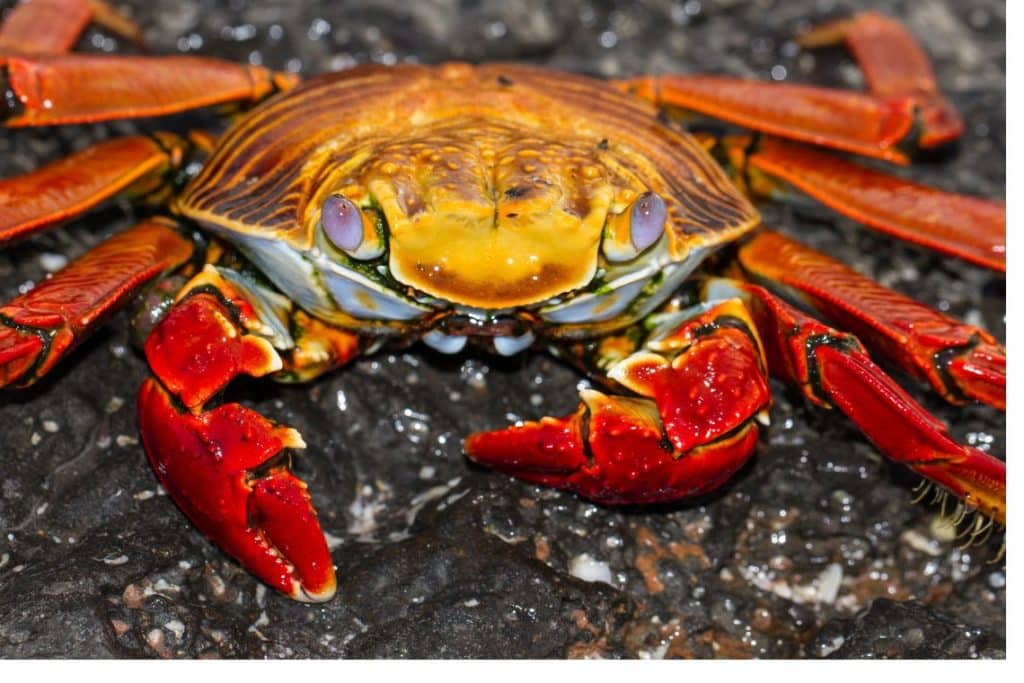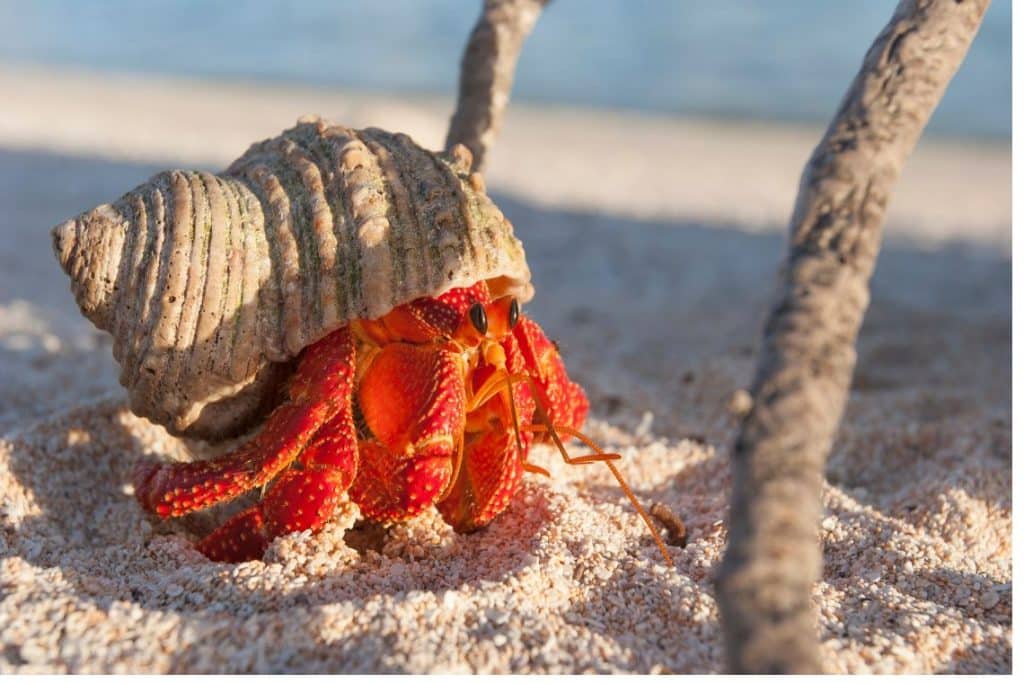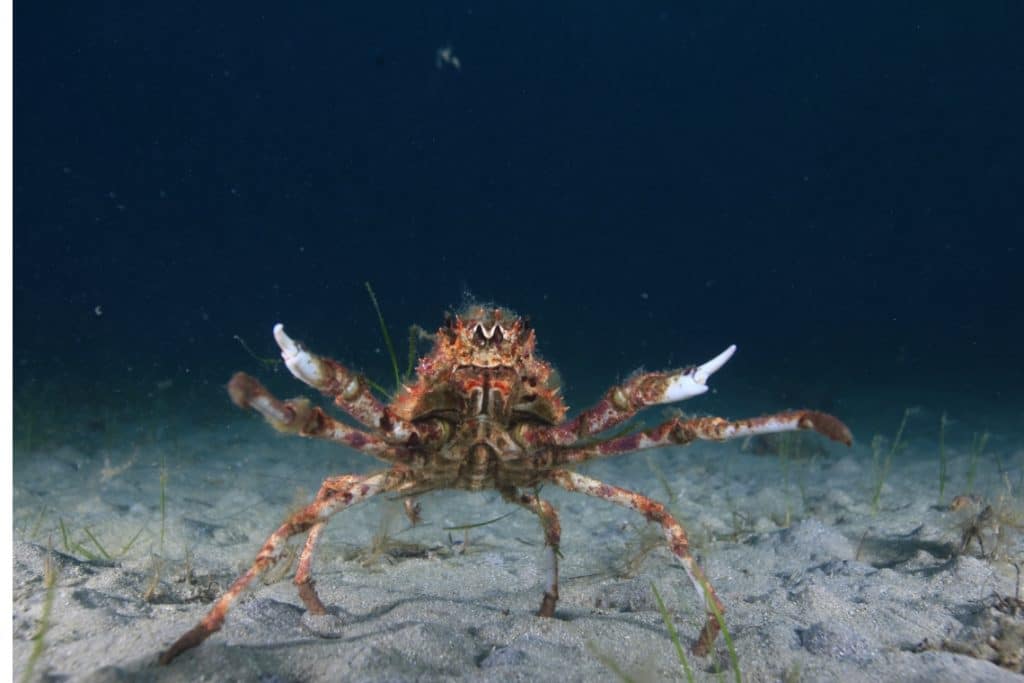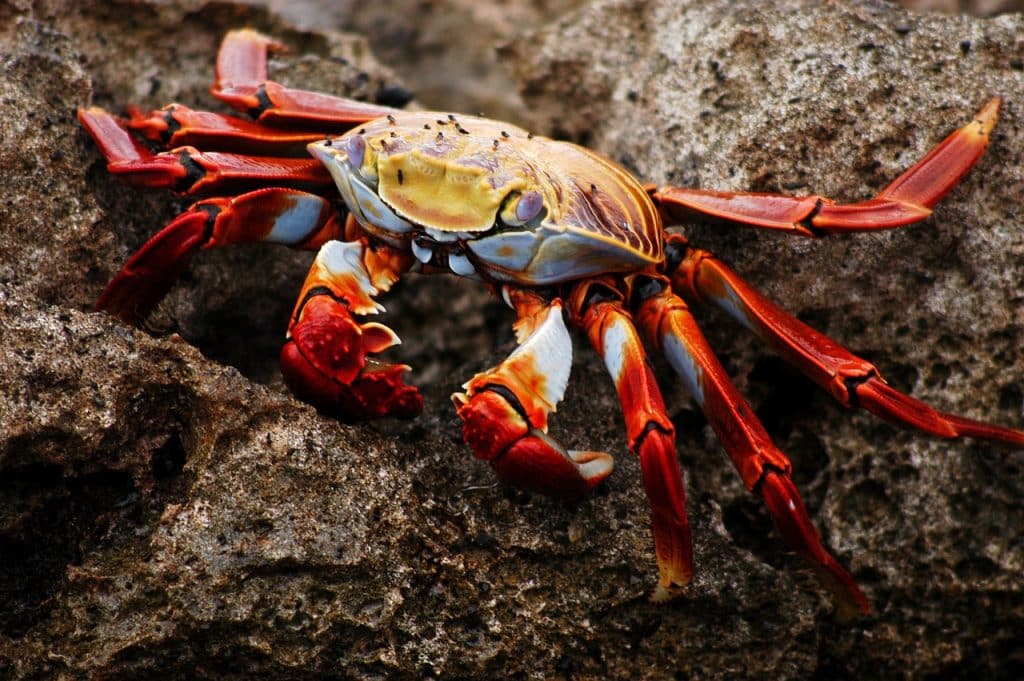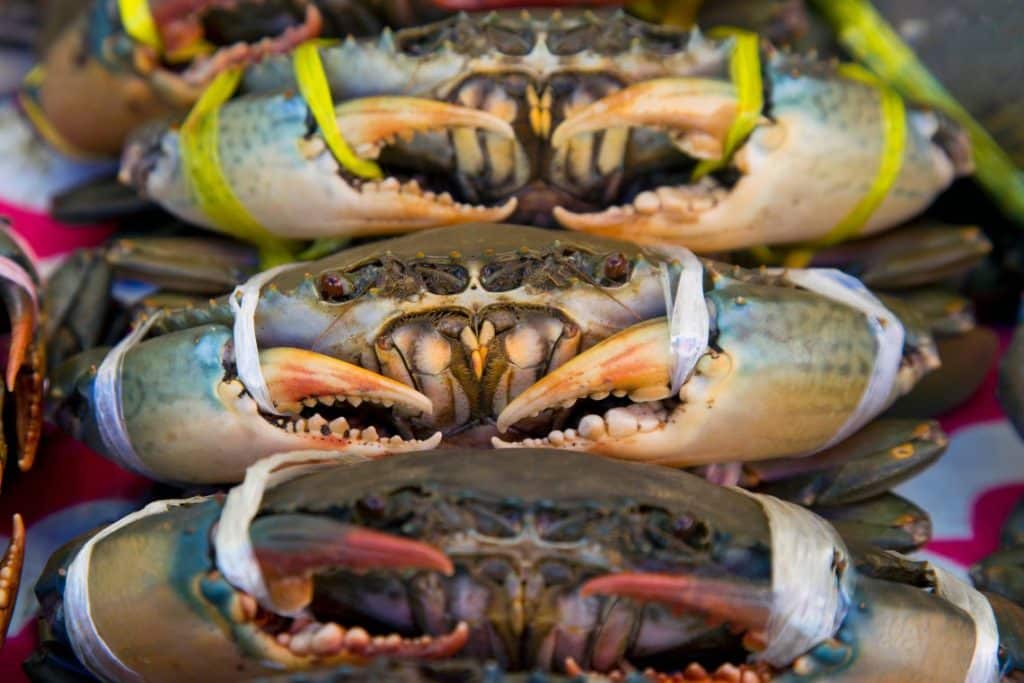Vampire crab is a fascinating species known for its unique appearance and behavior. Found in freshwater habitats, this small crab has distinctive red eyes and color patterns on its body.
Read More:
With a maximum size of just 2 inches, vampire crabs are popular pets due to their low maintenance requirements and interesting personality. They are mainly carnivorous, feeding on small insects, worms, and even carrion. Vampire crabs also have the ability to climb and are excellent escape artists, so providing a secure and well-maintained tank is essential.
Additionally, these crabs require a brackish environment with access to land and water, allowing them to exhibit their natural behaviors. Overall, vampire crabs offer a unique and captivating addition to any aquarium setup.

Unveiling The Mystery: Discovering The Power Of Vampire Crab
Delve into the enigmatic realm of vampire crabs and uncover their formidable potency. Unleash the captivating power they possess and witness the marvel of these intriguing creatures.
A Brief Introduction To The Vampire Crab Species
Vampire crabs, also known as Geosesarma sp. Or Thai Devil crabs, are fascinating creatures native to the freshwater streams and swamps of Southeast Asia. With their vibrant colors and distinct markings, these small crustaceans have captured the attention of aquarium enthusiasts and nature lovers alike.
But what sets Vampire crabs apart from other species? Let’s delve into the unique characteristics that make them intriguing.
The Unique Characteristics That Make Vampire Crabs Intriguing
- Compact Size: Vampire crabs are small in size, typically measuring around 1-2 inches wide. Their petite stature makes them a suitable choice for aquariums or terrariums.
- Extraordinary Colors: One of the most captivating features of Vampire crabs is their vibrant hues. Ranging from fiery orange and deep red to electric blue and striking purple, their dazzling colors make them stand out amongst their aquatic counterparts.
- Spectacular Markings: Their intricately patterned carapace, often adorned with intricate lines, spots, or swirls, adds an element of mystery and allure to the Vampire crab’s appearance.
- Land and Water Adaptability: Unlike most crabs, Vampire crabs have adapted to live both on land and in water. They possess the ability to breathe atmospheric air, allowing them to explore both terrestrial and aquatic environments.
- Males vs. Females: Male Vampire crabs are usually larger in size and boast more vibrant colors compared to their female counterparts. Males also possess uniquely shaped claws, which they use during courtship and territorial displays.
Understanding The Enigmatic Power Possessed By Vampire Crabs
- Ecosystem Balance: In their natural habitats, Vampire crabs play a crucial role in maintaining the ecological balance. They contribute to nutrient cycling by scavenging on decaying organic matter, helping to keep their surroundings clean.
- Algae Control: Vampire crabs have a voracious appetite for algae, making them excellent natural cleaners for aquariums. By devouring algae growth, they assist in preventing the overgrowth of unwanted greenery in their aquatic homes.
- Territorial Nature: Vampire crabs are known for their territorial behavior, defending their chosen area from intruders. This behavior ensures stability within their habitat and prevents overcrowding.
- Natural Hunters: Despite their small size, Vampire crabs are predatory and possess powerful claws. They feed on small invertebrates, insects, and even carrion, making them effective predators in their ecosystem.
- Educational Wonders: With their captivating colors, adaptable behaviors, and unique characteristics, Vampire crabs have become popular choices for educational displays and research projects. These enigmatic creatures offer numerous opportunities to study crustacean biology and behavior in controlled environments.

Vampire crabs continue to mesmerize and captivate enthusiasts with their striking appearance and intriguing qualities. As we unravel their enigmatic power, we gain a deeper understanding of their significance in both their native ecosystems and our own curated habitats
The Fascinating Adaptations Of Vampire Crabs
Vampire Crabs exhibit fascinating adaptations in their unique coloration, behavior, and claw shape, making them captivating creatures for enthusiasts. These crabs boast vibrant colors, intricate patterns, and distinctive claw formations that make them stand out in the world of crustaceans.
With their striking appearance and intriguing name, Vampire Crabs have captivated the attention of many. These small terrestrial crabs have several fascinating adaptations that allow them to thrive in their unique habitats. In this section, we will explore the habitat and range of Vampire Crabs, as well as their remarkable physical characteristics and how they have adapted to their environment.
An Exploration Of The Vampire Crab’S Habitat And Range:
- Vampire Crabs are native to the rainforests of Java and Sumatra in Indonesia.
- They prefer areas with high humidity levels, such as dense vegetation and leaf litter on the forest floor.
- These crabs often inhabit small, slow-moving streams and ponds within the rainforest.
- Due to deforestation and habitat destruction, their natural range has become limited, leading to the rise of captive breeding programs.
The Remarkable Physical Characteristics Of Vampire Crabs:
- Vampire Crabs are named for their vibrant colors, which range from shades of purple and blue to orange and red.
- They have a robust, compact body with sturdy legs and a carapace that measures about 2-3 inches in diameter.
- One of their most striking features is their pair of large, claw-like pincers, which they use for defense and maintaining territory.
- These crabs also have specialized brushes on their walking legs that help absorb moisture from their surroundings.
How Vampire Crabs Have Adapted To Their Environment:
- Vampire Crabs possess the ability to breathe both underwater and on land, thanks to specialized gills and modified lungs called “pseudotrachea.”
- Their vibrant coloration acts as camouflage, helping them blend into the colorful leaf litter and detritus found on the rainforest floor.
- These crabs have developed excellent climbing abilities, allowing them to navigate the intricate root systems and vegetation of their habitat.
- To cope with the limited food sources in their environment, Vampire Crabs are known to scavenge for plant matter, decomposing organic material, and small invertebrates.
Vampire Crabs have evolved intriguing adaptations that enable them to thrive in the rainforest habitat. Their remarkable physical characteristics, combined with their unique ability to breathe both underwater and on land, make them truly fascinating creatures. As we continue to learn more about these captivating crabs, it’s crucial to ensure their conservation to preserve their natural habitats for generations to come.
The Feeding Habits Of Vampire Crabs
Vampire crabs possess intriguing feeding habits, devouring various foods with their tiny yet powerful claws. From insects to plant matter, these fascinating creatures exhibit an appetite that is both unique and captivating.
Unraveling The Mystery Of The Vampire Crab’S Diet
Vampire crabs, also known as Geosesarma dennerle, are fascinating creatures that inhabit the mangrove forests of Southeast Asia. These small, colorful crabs have captured the curiosity of many aquarium enthusiasts due to their unique appearance and intriguing behavior. One aspect that often raises questions among crab enthusiasts is their feeding habits.
How do these nocturnal creatures obtain their nutrition in the wild? Let’s dive in and explore the feeding behaviors and strategies of the Vampire Crab.

Examining The Feeding Behaviors And Strategies Of Vampire Crabs
Vampire crabs are omnivorous creatures, meaning they consume both plant and animal matter. To better understand their feeding habits, let’s take a closer look at the strategies they employ in their search for sustenance:
- Scavenging: Vampire crabs have been observed scavenging on the forest floor, feeding on decaying leaves, fruits, and dead insects. They are equipped with sharp claws, which they use to rip apart their food and extract nutrients.
- Algae grazing: These crabs are also known to graze on algae that grow on rocks, logs, and other surfaces in their habitat. Their small size allows them to maneuver easily, reaching tight spaces to feed on algae and microscopic organisms attached to surfaces.
- Hunting small prey: While primarily relying on scavenging and grazing, Vampire crabs have been observed hunting small invertebrates. They use their pincer-like mouthparts to catch and consume insects, worms, snails, and other tiny creatures.
- Filter feeding: In addition to their omnivorous diet, Vampire crabs have been observed engaging in filter feeding behavior. They position themselves in areas with high water flow, using their bristle-like mouthparts to trap and filter out microscopic food particles suspended in the water.
How Vampire Crabs Obtain Their Nutrition In The Wild
In their natural habitat, Vampire crabs have access to a wide range of food sources, allowing them to maintain a balanced diet. Here’s how they obtain their nutrition:
- Plant matter: Vampire crabs feed on decaying leaves, fruits, and other plant material found on the forest floor. These provide them with essential nutrients and fiber.
- Algae: The crabs graze on algae that grow on various surfaces in their environment. This not only provides them with nutrition but also helps with their digestion.
- Insects and invertebrates: Vampire crabs satisfy their protein requirements by hunting small insects, worms, snails, and other invertebrates that come their way. They are opportunistic hunters and use their sharp claws to capture their prey.
- Microscopic organisms: By engaging in filter feeding behavior, Vampire crabs can obtain nutrition from tiny particles suspended in the water. This includes microorganisms like plankton and other microscopic life forms.
The feeding habits of Vampire crabs are diverse, reflecting their adaptability to different food sources. By scavenging, grazing, hunting small prey, and filter feeding, these fascinating creatures ensure they acquire the necessary nutrients for their survival. Observing their diet in the wild provides valuable insights for enthusiasts who wish to ensure optimal nutrition for Vampire crabs in captivity.
Reproduction And Life Cycle Of Vampire Crabs
Vampire crabs undergo a fascinating reproductive life cycle. Starting as larvae in freshwater, they eventually transition to land-dwelling adults after a series of molts. These crabs are known for their unique and captivating behavior, making them an intriguing addition to any aquatic or reptile tank.
A Detailed Look At The Mating Rituals Of Vampire Crabs
Vampire Crabs are fascinating creatures when it comes to their mating rituals. Here, we will take a detailed look at how these unique crabs reproduce and engage in courtship.
- Courtship displays: Male Vampire Crabs perform elaborate courtship displays to attract females. These displays can involve waving their claws, performing dance-like movements, and even making sounds to communicate their availability and interest.
- Searching for a mate: Once the male has caught the female’s attention with his courtship display, he will approach her carefully and initiate physical contact. This can involve touching antennae, tapping the female’s carapace, or even picking her up.
- The final connection: Once the female accepts the male’s advances, they will engage in mating. The male uses specialized appendages called gonopods to transfer sperm to the female. This process can take several hours, during which the male cradles the female, forming a bond between them.

The Unique Reproductive Strategies Employed By Vampire Crabs
Vampire Crabs have evolved some unique reproductive strategies that set them apart from other species. These strategies ensure the survival and success of their offspring.
- Semiterrestrial eggs: Unlike many other crab species, Vampire Crabs lay their eggs outside of water. Females create small nests on land or in damp areas, where they deposit their eggs. This adaptation allows the eggs to develop in a more controlled environment away from potential predators.
- Egg care: Female Vampire Crabs are very protective of their eggs. They use specialized hairs on their abdomen to keep the eggs moist and constantly groom them to prevent fungal infections. This maternal care ensures the survival of the developing embryos.
- Semi-terrestrial larval stage: After the eggs hatch, the larvae are still dependent on a water source, although they can tolerate brief periods on land. They have gill structures to extract oxygen from water, enabling them to survive in both aquatic and terrestrial environments. This adaptability is crucial for their survival as they transition to adulthood.
The Life Cycle Of Vampire Crabs From Birth To Adulthood
Vampire Crabs go through several stages of development before reaching adulthood. Let’s explore their life cycle in detail.
- Egg stage: After mating, the female Vampire Crab carries the fertilized eggs until they are ready to be laid. She carefully selects a suitable spot on land or in damp areas to create a nest. The eggs remain in the nest until it is time for them to hatch.
- Larval stage: Once the eggs hatch, the larvae enter the water and go through several molting stages. In this stage, they resemble miniature versions of the adults and develop gills to extract oxygen from the water. During this time, they feed on zooplankton and other small organisms.
- Juvenile stage: As the larvae continue to grow, they undergo several molting cycles, shedding their exoskeleton to accommodate their increasing size. In this stage, they transition from a fully aquatic lifestyle to a more semi-terrestrial one, spending time both in water and on land.
- Adult stage: After completing the juvenile stage, the Vampire Crabs reach adulthood. They have fully developed claws and specialized adaptations that allow them to thrive in their unique habitat. They are now ready to engage in courtship and continue the cycle of reproduction.
Now that you have a detailed understanding of the reproduction and life cycle of Vampire Crabs, you can appreciate the intricacies of their behavior and survival strategies.
The Social Behavior Of Vampire Crabs
Vampire crabs display intriguing social behavior as they establish territories, communicate through various gestures, and engage in hierarchical dominance. These small freshwater crabs exhibit fascinating patterns of interaction and can make captivating additions to aquariums or habitats.

With their striking colors and unique appearance, Vampire Crabs are fascinating creatures to observe in a captive setting. These small crustaceans are not only visually captivating, but they also exhibit interesting social behaviors within their own communities. Let’s delve into the social dynamics of Vampire Crabs and explore how they communicate, interact, and establish hierarchies among themselves.
Exploring The Social Dynamics Within Vampire Crab Communities
Vampire Crabs, like many other animals, have a natural instinct to form social bonds within their communities. These social dynamics are crucial for their overall well-being and survival. Here are some key points to consider:
- Vampire Crabs are known to live in groups, typically consisting of one dominant male and several females.
- Within these groups, individuals establish territories where they live and forage for food. These territories are actively defended against intruders.
- Communication among Vampire Crabs occurs through a combination of visual displays and chemical signals.
- Vampire Crabs use their vibrant coloration and unique body postures to communicate their social status, intentions, and warnings to other members of the community.
- Chemical signals, released through scent glands, also play a significant role in communication. These chemical cues help individuals recognize each other, establish dominance, and maintain social order.
- The level of social interaction can vary among Vampire Crab species, but overall, they engage in activities such as social grooming, mating, and cooperative parenting.
How Vampire Crabs Communicate And Interact With One Another
Vampire Crabs have evolved various techniques to communicate and interact with their community members. Here’s a closer look at their communication methods:
- Visual displays: Through the use of vibrant colors and unique body postures, Vampire Crabs visually convey important messages to their fellow crabs. For example, a dominant male may display aggressive postures to establish its authority, while subordinate individuals may exhibit submissive behaviors.
- Chemical signals: By releasing specific chemicals through scent glands, Vampire Crabs communicate a wide range of information, including their status, readiness to breed, and territorial boundaries.
- Touch and antennae movement: Vampire Crabs also rely on physical contact and antenna movements to communicate non-verbally. These tactile interactions can convey aggression, cooperation, or reproductive readiness.
- Vocals: While Vampire Crabs do not produce audible sounds, they may use vibrations or clicks as a form of communication. These sounds are typically used during courtship or confrontations.
Examining The Hierarchy And Social Structures Among Vampire Crabs
Within Vampire Crab communities, a hierarchy and social structure naturally emerge. Here are some important aspects to consider:
- Dominant male: The dominant male holds the highest rank within the group. It establishes and defends its territory, mates with the females, and has priority access to resources.
- Subordinate males: Subordinate males exist within the community but are not dominant. They may challenge the dominant male or attempt to mate with females when given the opportunity.
- Females: Female Vampire Crabs play a crucial role in maintaining the social structure. They support the dominant male’s authority, while also engaging in cooperative behaviors like social grooming and caring for young.
- Juveniles: Juvenile Vampire Crabs occupy lower positions within the hierarchy and gradually mature into adult roles over time.
Understanding the social behaviors of Vampire Crabs provides valuable insights into their natural history and aids in creating optimal captive environments for these captivating creatures. By studying their communication methods and social structures, we can ensure the well-being and success of these unique crustaceans in captivity.

The Conservation Status And Threats To Vampire Crabs
The vampire crab, known for its unique appearance and behavior, faces various threats to its conservation status. Environmental changes, habitat destruction, and invasive species are among the challenges that threaten the survival of these remarkable creatures.
Assessing The Current Conservation Status Of Vampire Crabs:
- Vampire crabs (Geosesarma sp.) Are a species of small, colorful land crabs native to the tropical rainforests of Java and Bali islands in Indonesia.
- Despite their intriguing appearance and unique characteristics, vampire crabs face various conservation challenges.
- The IUCN (International Union for Conservation of Nature) has not assessed the conservation status of vampire crabs specifically. However, it is crucial to monitor and protect their populations due to their limited geographic range and habitat degradation.
Identifying The Primary Threats And Challenges Faced By Vampire Crabs:
- Habitat Loss: The conversion of land for agriculture, urbanization, and deforestation pose significant threats to the vampire crabs’ natural habitats.
- Pollution: Water pollution from chemicals, pesticides, and waste runoff can negatively impact the water quality and ecosystems where vampire crabs dwell.
- Invasive Species: The introduction of non-native species into vampire crab habitats can disrupt local ecosystems and compete for resources.
- Overcollecting: The demand for vampire crabs in the pet trade has led to overcollection and exploitation, threatening their wild populations.
Measures Being Taken To Protect And Preserve Vampire Crab Populations:
- Protected Areas: Establishing protected areas and nature reserves can help ensure the preservation of vampire crab habitats and enable the enforcement of conservation regulations.
- Conservation Education: Raising awareness about the importance of vampire crabs and their ecosystems through education programs can encourage responsible behavior and reduce threats.
- Sustainable Harvesting: Implementing regulations and guidelines for the pet trade industry to ensure sustainable practices, such as captive breeding and avoiding collection from the wild.
- Research and Monitoring: Conducting research on vampire crab ecology, population dynamics, and habitat requirements aids in developing effective conservation strategies.
- Community Engagement: Involving local communities in conservation efforts by providing alternative livelihood opportunities that are compatible with vampire crab conservation goals.
By addressing the conservation status, threats, and conservation measures related to vampire crabs, we can work towards safeguarding these fascinating and ecologically important creatures for future generations. It is essential that we take collective action to protect their habitats and promote responsible practices to ensure their long-term survival.

Vampire Crab Enthusiasts: A Growing Community
Discover the passionate community of Vampire Crab enthusiasts, where the love for these unique crustaceans is growing. Join fellow enthusiasts in exploring the fascinating world of Vampire Crabs.
The Rise In Popularity Of Vampire Crabs Among Aquarists
Vampire Crabs, with their stunning colors and unique attributes, have gained immense popularity among aquarists in recent years. Here are some factors contributing to the rise in the vampire crab enthusiasts community:
- Unique Appearance: Vampire Crabs feature vibrant colors like orange, purple, and blue, making them visually striking. Their dark-colored bodies and bright yellow eyes give them an intriguing vampire-like appearance, which attracts aquarists seeking distinctive pets.
- Small Size: These crabs are relatively small, growing up to only 1.5 inches in size. Their compact nature makes them suitable for smaller aquarium setups, such as nano tanks.
- Ease of Care: Vampire Crabs require minimal care compared to other aquatic pets. Some key reasons include:
- Adaptability: Vampire Crabs have the ability to thrive in both freshwater and brackish water setups, providing flexibility for aquarists.
- Low Space Requirement: These crabs can be kept in smaller tanks since they don’t require vast swimming areas. A 5-gallon tank is sufficient for a pair of vampire crabs.
- Compatibility: Vampire Crabs can coexist with other peaceful fish species, as long as their tank mates are not aggressive or too large to pose a threat.
- Feed Flexibility: These crabs have an omnivorous diet, meaning they can eat both plant matter and protein-rich foods like fish flakes, pellets, and small live or frozen invertebrates.
- Moderate Temperature Range: Vampire Crabs can tolerate a wide range of water temperatures, typically between 70 to 82°F (21 to 28°C), making them adaptable to various setups.
The Appeal Of Vampire Crabs As Pets And Their Care Requirements
Alongside their striking appearance and ease of care, Vampire Crabs offer unique features that entice individuals as potential pet owners. Consider the following factors when contemplating adopting Vampire Crabs:
- Interactive Behavior: Unlike many other crab species that tend to be more reclusive, Vampire Crabs have an active and curious disposition, making them highly engaging pets. They often explore their surroundings, climb on driftwood, and even swim in water.
- Aesthetically Pleasing Enclosures: Designing an attractive aquarium setup is a pleasure due to the vampire crabs’ vibrant colors. You can enhance this visual appeal by adding live plants, driftwood, and other natural decorations.
- Naturalistic Habitat: Vampire Crabs are naturally found in tropical regions like Java and Sumatra. Creating a habitat that mimics their natural environment is not only visually appealing but also provides enrichment for the crabs.
- Territorial Behavior: Vampire Crabs demonstrate interesting territorial behavior by creating burrows and defending their space. Observing these behaviors adds intrigue and interest to their care routine.
Resources And Communities For Vampire Crab Enthusiasts
The growing community of vampire crab enthusiasts has led to various resources and communities where information, advice, and discussions can be exchanged. Here are some invaluable resources for those interested in joining the vampire crab enthusiasts community:
- Online Forums and Communities: Platforms such as Reddit and Fishkeeping World have dedicated sections where aquarists can discuss vampire crabs, share experiences, and seek advice from fellow enthusiasts.
- Social Media Groups: Facebook groups, such as “Vampire Crab Enthusiasts” and “Crustacean Corner,” serve as excellent hubs for vampire crab enthusiasts to connect, share photos, and exchange knowledge.
- Specialized Websites and Blogs: Several websites and blogs provide comprehensive care guides, tank setup ideas, and in-depth information on vampire crabs. Websites like Aquariadise and The Spruce Pets offer valuable resources for both beginners and experienced crab keepers.
- Local Aquarium Clubs and Societies: Joining local aquarium clubs and societies can help connect with like-minded individuals in your area. These organizations often host events, meetings, and even competitions where vampire crab enthusiasts can gather.
Immersing oneself in these resources and engaging with the vampire crab enthusiasts community can provide a wealth of knowledge and a strong support system for anyone passionate about these captivating aquatic creatures.
Vampire Crabs In Mythology And Popular Culture
Vampire crabs have captured the attention of mythology and popular culture due to their mysterious and intriguing nature. These fascinating creatures are often associated with dark legends and supernatural tales.

Vampire Crabs have fascinated and captivated the imaginations of people worldwide, making appearances in various forms of literature, art, and media. These unique creatures have become symbols and representations in folklore and mythology, embodying both intrigue and mystery. Let’s explore how Vampire Crabs have left their mark on the cultural landscape.
Vampire Crabs As Symbols And Representations In Folklore And Mythology:
- Vampire Crabs are often associated with the supernatural and mythical creatures due to their intriguing appearance and behavior.
- In Malaysian folklore, Vampire Crabs are believed to possess magical powers and are associated with good luck and prosperity.
- These crabs have been linked to the legend of blood-sucking vampires in some cultures, symbolizing the darker aspects of vampiric folklore.
- Vampire Crabs are seen as symbols of transformation and regeneration in certain mythologies, representing the cycle of life and death.
The Presence Of Vampire Crabs In Literature, Art, And Media:
- Vampire Crabs have made their way into various literary works, becoming characters in stories and novels that explore their mythical qualities.
- Artists have been inspired by the unique appearance of Vampire Crabs, creating stunning visual representations in paintings, sculptures, and other art forms.
- Movies, TV shows, and video games have also featured Vampire Crabs, capitalizing on their mysterious allure and incorporating them into captivating storylines.
- The popularity of Vampire Crabs in media has further fueled people’s fascination with these intriguing creatures.
How Vampire Crabs Have Captured The Imaginations Of People Worldwide:
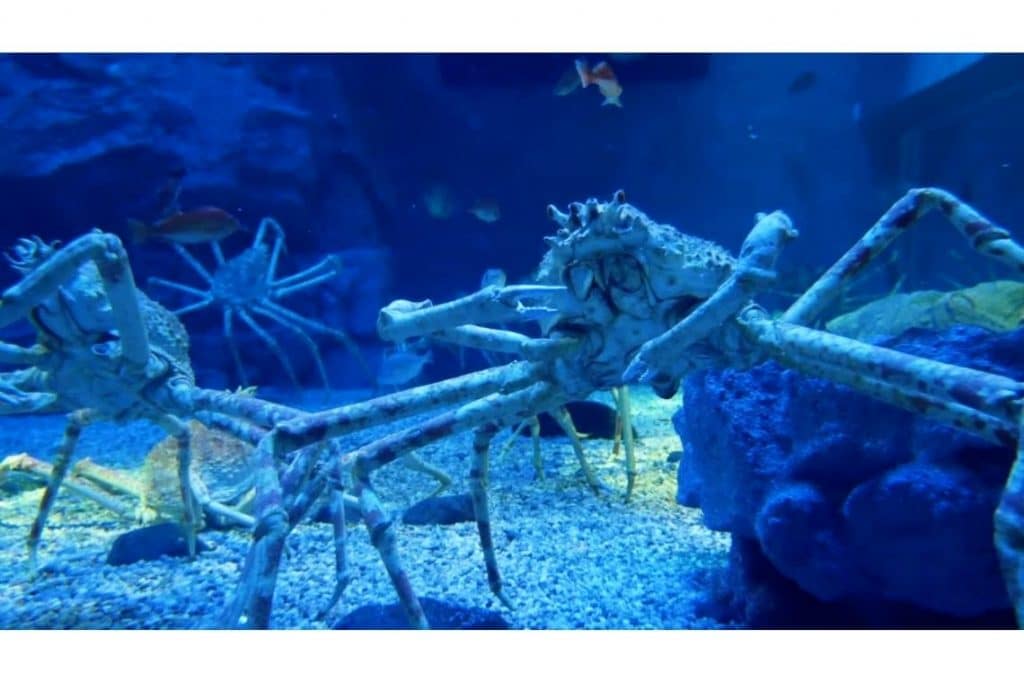
- Vampire Crabs’ distinctive appearance, with their dark colors and intricate patterns, has made them popular among aquarium enthusiasts and collectors.
- Their small size and relatively low maintenance requirements make Vampire Crabs accessible to a wide range of people interested in keeping them as pets.
- Vampire Crabs have become social media sensations, with enthusiasts sharing pictures and videos showcasing their beauty and unique characteristics.
- The allure of Vampire Crabs lies in their ability to evoke a sense of wonder and mystery, igniting the imagination of people around the world.
Vampire Crabs hold a significant place in both mythology and popular culture. From their symbolic representations in folklore to their presence in various forms of art and media, these intriguing creatures continue to captivate the hearts and minds of people worldwide.
Whether as pets, artistic inspirations, or sources of mythical intrigue, Vampire Crabs have left a lasting impact.
Vampire Crab Research And Scientific Discoveries
Discover the latest vampire crab research and scientific findings, uncovering fascinating insights into these intriguing creatures. Dive into the world of vampire crabs and explore their unique behaviors and adaptations.
****
Vampire crabs, known for their mystical appearance and unique behavior, have been the focus of extensive scientific research and discoveries over the years. These captivating creatures, with their vibrant colors and distinctive claws, have caught the attention of researchers and explorers alike.
In this section, we will delve into the recent scientific studies and discoveries related to vampire crabs, as well as explore the ongoing research and future avenues of study for a better understanding of their enigmatic power.
Recent Scientific Studies And Discoveries Related To Vampire Crabs
- Vampire crab behavior and adaptation:
- Vampire crabs have demonstrated remarkable adaptations to their environment, including their ability to survive in both land and water.
- Recent studies have shed light on the unique feeding behavior, reproductive strategies, and social dynamics of vampire crabs.
- Genetic research and species classification:
- With advancements in DNA sequencing techniques, scientists have been able to unravel the genetic makeup of vampire crabs, leading to a better understanding of their evolutionary history.
- Recent discoveries have led to the identification of new species and subspecies, broadening our knowledge of vampire crab diversity.
- Ecological studies and habitat conservation:
- Researchers have embarked on ecological studies to determine the impact of habitat loss and fragmentation on vampire crab populations.
- These studies aim to establish effective conservation strategies to protect the natural habitats of these enchanting creatures.

The Ongoing Research And Exploration Of Vampire Crab Species
- Morphological studies and camouflage mechanisms:
- Ongoing research is focused on examining the intricate anatomical features of vampire crabs that enable them to blend seamlessly into their surroundings.
- Scientists are studying the unique camouflage mechanisms employed by these crabs to evade predators and remain hidden from prey.
- Physiological adaptations and survival strategies:
- Ongoing studies are uncovering the physiological adaptations that allow vampire crabs to thrive in extreme environments, such as low oxygen levels and fluctuating temperatures.
- Understanding these survival strategies can pave the way for applications in fields such as biomedical research and bio-inspired technology.
- Behavior and social interactions:
- Researchers continue to investigate the complex social interactions and communication methods employed by vampire crabs.
- Ongoing studies aim to unravel the intricate behavioral patterns, dominance hierarchies, and mating rituals displayed by these intriguing creatures.
Future Avenues Of Study For Better Understanding The Enigmatic Power Of Vampire Crabs
- Neurological studies and sensory perception:
- Future research could delve into the fascinating neurological aspects of vampire crabs, examining their sensory perception and cognitive abilities.
- Understanding how these crabs process information from their environment can provide valuable insights into their unique behavior.
- Reproductive strategies and offspring development:
- Further studies could explore the reproductive strategies of vampire crabs, including parental care and offspring development.
- Investigating these aspects would contribute to our understanding of the evolutionary mechanisms driving the survival and success of vampire crab populations.
- Conservation and sustainable management practices:
- Future research efforts could focus on developing sustainable management practices for vampire crab habitats, ensuring their long-term survival and preservation.
- By understanding the ecological role of these crabs and the importance of their habitats, conservation initiatives can be tailored effectively.
As our understanding of vampire crabs continues to evolve, the ongoing research and scientific discoveries bring us closer to unraveling the mysteries that surround these elusive creatures. The exploration of their behavior, adaptation, and ecological significance holds immense promise for both scientific knowledge and conservation efforts.
Frequently Asked Questions Of Vampire Crab
Are Vampire Crabs Aggressive To Humans?
Vampire crabs are not aggressive towards humans. They pose no threat and are generally docile.
Why Are Vampire Crabs Called Vampire?
Vampire crabs are called vampire due to their dark coloration and blood-red eyes.
Can Vampire Crab Live Out Of Water?
Yes, vampire crabs can live out of water for short periods of time.
Why Are Vampire Crabs Endangered?
Vampire crabs are endangered due to habitat loss, pollution, and illegal pet trade.
Conclusion
The Vampire Crab is a fascinating creature that has captured the interest of many aquarium enthusiasts. With its unique appearance and intriguing behavior, it has become a popular choice for those looking to add something different to their tanks. This small, colorful crab is not only visually appealing but also relatively easy to care for, making it an ideal choice for both beginners and experienced hobbyists.
Its ability to adapt to different water conditions and its peaceful nature makes it a great addition to community tanks. Additionally, the Vampire Crab’s scavenging behavior helps to keep the tank clean by consuming uneaten food and decaying organic matter.

Whether you are a lover of freshwater creatures or simply looking to spice up your aquarium, the Vampire Crab is a captivating choice that is sure to impress. So why not consider adding this unique and intriguing crab to your collection?

